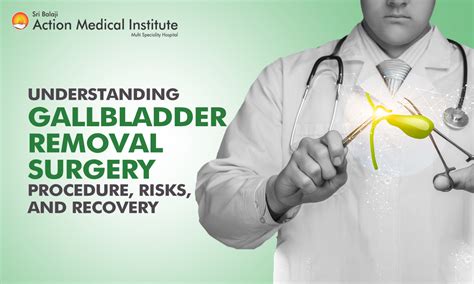The gallbladder, a small, pear-shaped organ located under the liver, plays a crucial role in the digestive system by storing bile, a fluid produced by the liver that aids in the breakdown and absorption of fats. Despite its importance, the gallbladder can sometimes become a source of significant pain and discomfort due to the formation of gallstones, inflammation, or other conditions that may necessitate its removal. Gallbladder surgery, also known as cholecystectomy, is a common procedure performed to treat gallbladder diseases, and it is essential to understand the details of this operation, especially in a medical emergency.
Understanding Gallbladder Diseases
Before delving into the specifics of gallbladder surgery, it’s vital to comprehend the conditions that may lead to the need for such an operation. Gallstones, which are small, hard deposits that can form in the gallbladder, are a primary reason for gallbladder removal. These stones can block the cystic duct, preventing bile from flowing out of the gallbladder, leading to severe abdominal pain, known as biliary colic. Inflammation of the gallbladder, or cholecystitis, can also occur, often as a result of a gallstone blocking the cystic duct. If left untreated, cholecystitis can lead to more severe complications, such as a ruptured gallbladder, which is a medical emergency.
Preparing for Gallbladder Surgery
In cases where surgery is deemed necessary, preparation is key to ensuring a smooth procedure and recovery. Patients undergoing gallbladder surgery should follow specific dietary instructions provided by their healthcare provider, which may include fasting for a certain period before the operation. Additionally, patients should inform their doctor about all medications they are taking, including herbal supplements and vitamins, as some may need to be stopped before surgery to prevent bleeding or other complications.
Surgical Options
There are primarily two types of gallbladder surgery: open cholecystectomy and laparoscopic cholecystectomy. The open procedure involves making a single large incision in the abdomen to remove the gallbladder. While effective, this method generally requires a longer recovery time compared to the laparoscopic approach. Laparoscopic cholecystectomy, on the other hand, involves making several small incisions through which a laparoscope (a thin, lighted tube with a camera) and surgical tools are inserted. This minimally invasive technique allows for a quicker recovery, less pain, and smaller scars. The choice between these two methods depends on the patient’s overall health, the severity of their condition, and the surgeon’s professional judgment.
The Surgical Procedure
During a laparoscopic cholecystectomy, the patient is placed under general anesthesia to ensure they do not feel pain during the procedure. The surgeon then makes the necessary incisions and inserts the laparoscope and surgical instruments. The bile ducts and blood vessels are carefully dissected and sealed off, and the gallbladder is removed through one of the incisions. If the surgeon encounters any difficulties during the laparoscopic procedure, they may decide to convert to an open cholecystectomy for the patient’s safety.
Recovery and Aftercare
After gallbladder surgery, patients typically spend a few hours in the recovery room, where they are monitored for any immediate complications. Most patients can go home the same day, but in some cases, an overnight hospital stay may be required. Postoperative care involves following a specific diet, usuallystarting with liquids and gradually moving to more solid foods, to help the body adjust to the absence of the gallbladder. Patients should also avoid strenuous activities, such as heavy lifting or bending, for a period recommended by their healthcare provider.
Potential Complications
As with any surgical procedure, there are potential risks and complications associated with gallbladder surgery. These may include infection, bleeding, injury to the bile duct or surrounding organs, and adverse reactions to anesthesia. In rare cases, patients may experience a condition known as postcholecystectomy syndrome, characterized by symptoms such as abdominal pain, diarrhea, and fatigue after gallbladder removal. It is crucial for patients to discuss these potential complications with their healthcare provider and to seek immediate medical attention if they experience any concerning symptoms after surgery.
Conclusion
Gallbladder surgery is a lifesaving procedure for individuals suffering from severe gallbladder diseases. Understanding the reasons for surgery, the types of surgical procedures available, and what to expect during recovery can help alleviate anxiety and ensure a smoother experience. While complications can occur, the vast majority of patients undergo gallbladder surgery without major issues and are able to return to their normal activities shortly after the procedure. If you or a loved one is facing a gallbladder condition, consulting with a healthcare professional can provide the necessary guidance and support to navigate this medical emergency effectively.
Frequently Asked Questions
What are the symptoms that may indicate the need for gallbladder surgery?
+Symptoms may include severe abdominal pain, especially after eating fatty foods, nausea, vomiting, fever, and jaundice. These symptoms can indicate the presence of gallstones or other gallbladder conditions that may require surgical intervention.
How long does it take to recover from gallbladder surgery?
+Recovery time can vary depending on the type of surgery performed. For laparoscopic cholecystectomy, most people can return to their normal activities within a week to 10 days. For open cholecystectomy, recovery may take longer, typically several weeks.
Can you live a normal life without a gallbladder?
+Yes, the majority of people can live normal, healthy lives without a gallbladder. The liver will continue to produce bile, which will flow directly into the small intestine, aiding in the digestion of fats. Some individuals may need to make dietary adjustments to manage potential side effects, such as diarrhea.
What are the risks of delaying gallbladder surgery if it is recommended?
+Delaying necessary gallbladder surgery can lead to increased risk of complications, such as a ruptured gallbladder, which is a medical emergency. It can also prolong the suffering from symptoms such as pain and discomfort, potentially affecting the quality of life.
How can one prevent gallstones and other gallbladder diseases?
+Maintaining a healthy weight, eating a balanced diet low in fats and sugars, staying hydrated, and exercising regularly can help reduce the risk of developing gallstones and other gallbladder conditions. However, genetics and certain medical conditions may also play a role, so regular check-ups with a healthcare provider are recommended.



